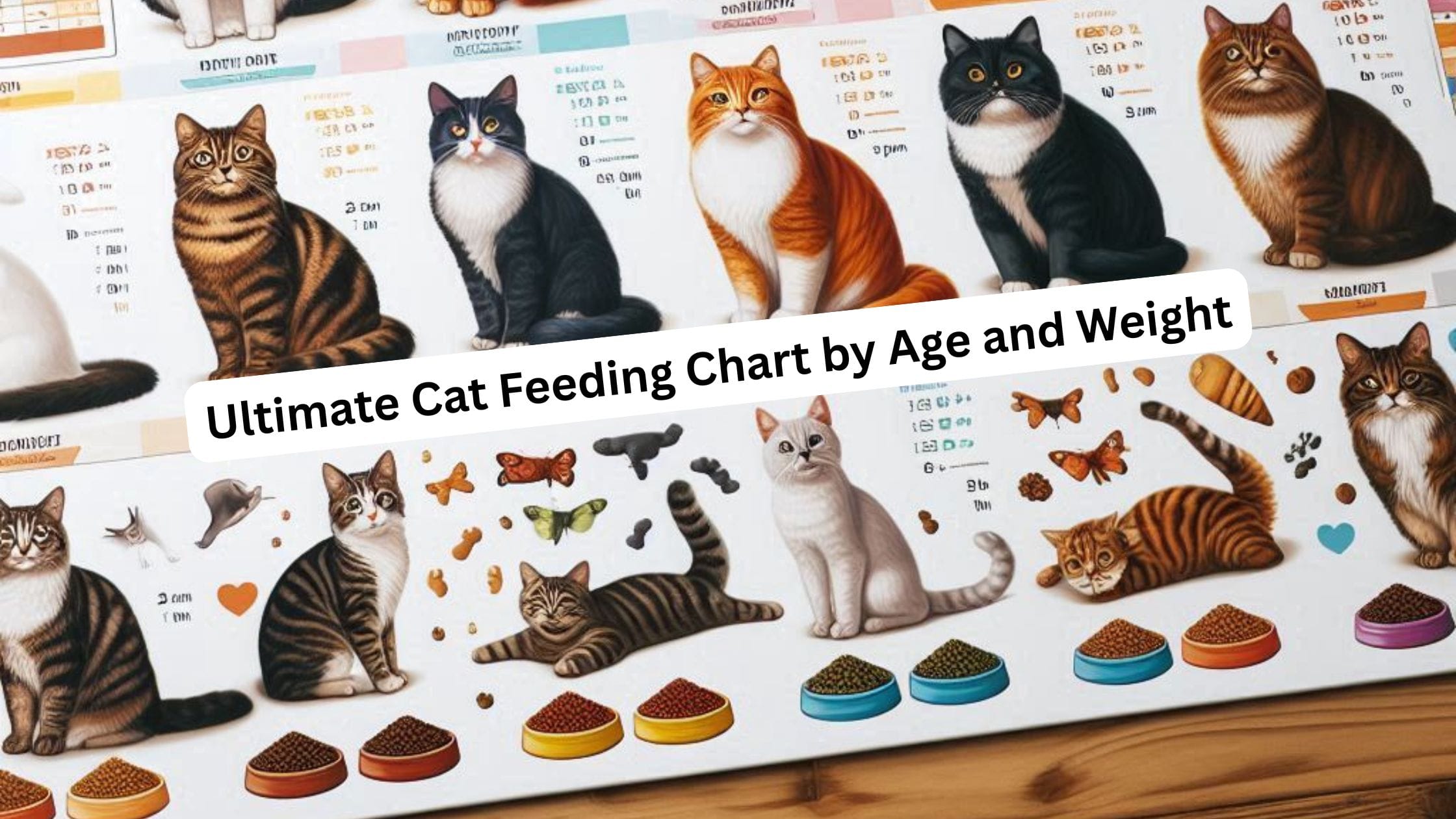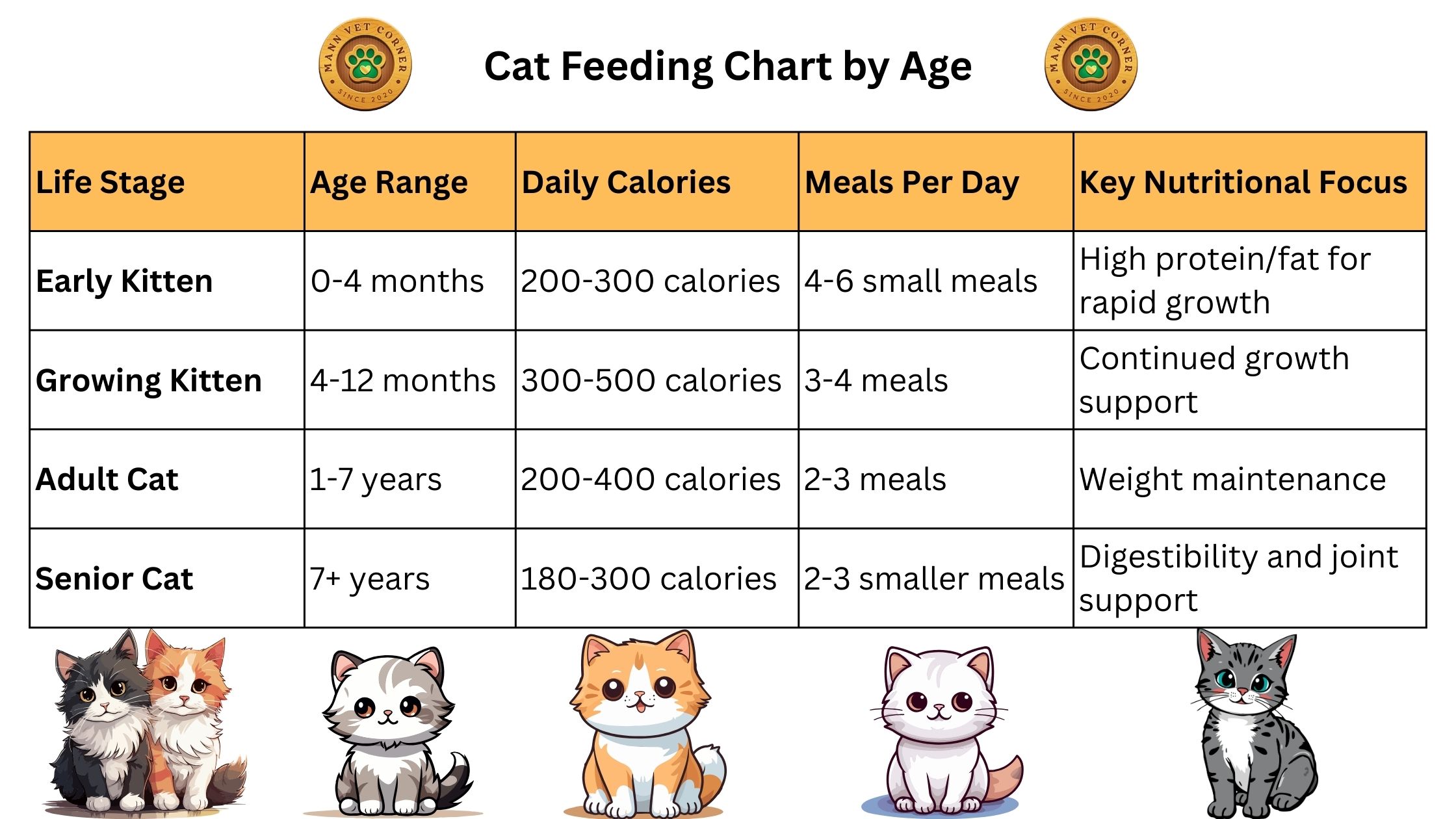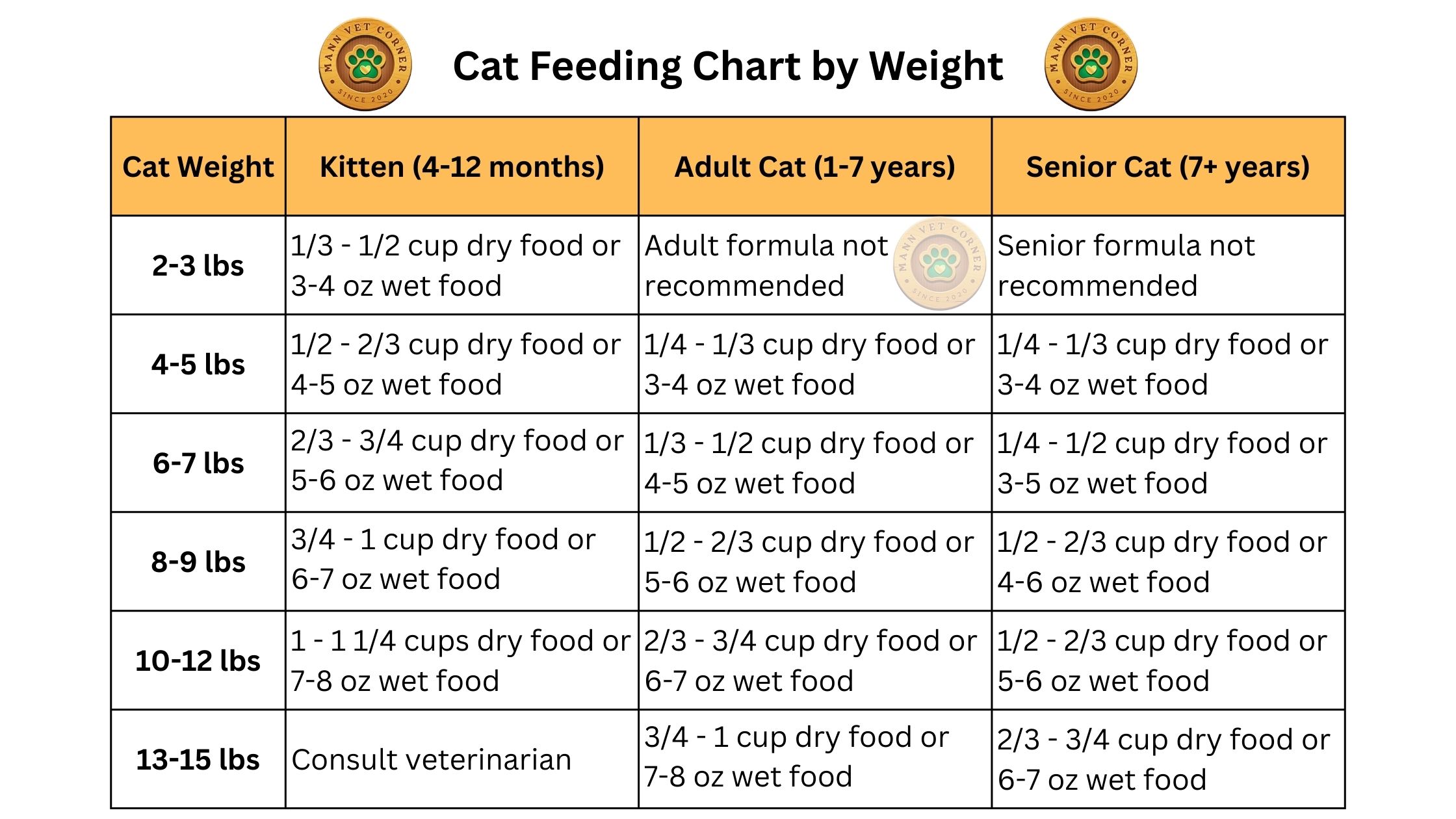I’ll never forget the day I brought home my first kitten, Whiskers. She was this tiny, fluffy ball of energy who seemed to have two modes: sleeping or eating everything in sight. Like many new cat parents, I panicked about feeding her properly. Was I giving her too much? Too little? Should I leave food out all day or stick to scheduled meals?
Three weeks later, Whiskers had transformed into a roly-poly kitten who could barely jump onto the couch. My vet gently explained that while my heart was in the right place, I’d been overfeeding her by nearly double the recommended amount. That’s when I learned the hard truth: getting your cat’s nutrition right isn’t just about love—it’s about precision.
Whether you’re dealing with a growing kitten, an active adult cat, or a senior feline companion, understanding how much to feed your cat based on their age and weight is crucial for their health and happiness. That’s exactly why I’ve created this comprehensive cat feeding chart by age and weight—to help you avoid the mistakes I made and give your furry friend the best possible start (or continuation) in life.
Understanding Cat Nutrition Basics
Before we dive into the nitty-gritty of feeding charts, let’s talk about what actually goes into your cat’s bowl and why it matters so much.
The Building Blocks of Feline Health
Cats are obligate carnivores, which means they’ve evolved to thrive on a diet that’s primarily meat-based. Unlike dogs (those food-loving opportunists!), cats have very specific nutritional needs that can’t be met by plant-based proteins alone.
Protein should make up the lion’s share of your cat’s diet—ideally 26% or more of their dry food and 12% or more of their wet food. This isn’t just about maintaining muscle mass; cats actually use protein for energy in ways that other animals don’t. Think of it as their premium fuel.
Fats are equally important, providing essential fatty acids that keep your cat’s coat shiny and their brain functioning optimally. Around 9% fat content in dry food and 5% in wet food hits that sweet spot.
Carbohydrates are where things get interesting. While cats don’t technically need carbs, small amounts (under 10% of their diet) can provide energy and help with digestion. The key word here is “small”—too many carbs can lead to obesity and diabetes.
The Great Wet vs. Dry Food Debate
Here’s where cat parents often get stuck: should you feed wet food, dry food, or both? From my experience working with countless cat families, the answer is usually “it depends.”
Wet food is fantastic for hydration (cats notoriously don’t drink enough water) and typically contains more protein per serving. It’s also easier for senior cats to eat and digest.
Dry food offers convenience and can help with dental health through the mechanical action of chewing. Plus, it’s generally more cost-effective and has a longer shelf life.
Many vets, including the ones I work with, recommend a combination approach—perhaps wet food for breakfast and dinner, with some high-quality dry food available for snacking.
Common Feeding Mistakes That Trip Up Cat Parents
Let’s address the elephant in the room: those feeding mistakes that seem logical but can actually harm your feline friend.
Free-feeding (leaving food out all day) might seem kind, but it makes portion control nearly impossible and can lead to overeating. Plus, if you have multiple cats, you’ll never know who’s eating what.
Using dog food in a pinch is a big no-no. Dog food doesn’t contain taurine, an essential amino acid that prevents heart disease in cats.
Ignoring life stage differences is another trap. A kitten’s nutritional needs are vastly different from a senior cat’s, and feeding them the same food can cause serious health issues.
Cat Feeding Chart by Age
Now let’s get into the meat and potatoes (or should I say, chicken and salmon?) of proper feeding based on your cat’s life stage.
Kittens (0-4 Months): The Rapid Growth Phase
During these early months, your kitten is basically a furry little growth machine. They’re doubling or even tripling their body weight, developing crucial muscle and bone structure, and burning through calories at an incredible rate.
Daily calorie needs: 200-300 calories per day (depending on size and activity level)
Meal frequency: 4-6 small meals throughout the day
Special considerations: Kitten-specific food is non-negotiable here, it contains the higher protein and fat levels these little ones need.
For the first 4-6 weeks, kittens should ideally stay with mom and nurse exclusively. If you’re bottle-feeding an orphaned kitten, you’ll need to feed them every 2-3 hours, including overnight. I know, I know—it’s exhausting, but it’s temporary!
Once they start showing interest in solid food (usually around 4 weeks), you can begin introducing wet kitten food mixed with a little warm water to create a soupy consistency.
Kittens (4-12 Months): The Energizer Bunny Stage
This is when your kitten feeding schedule becomes a bit more manageable, but their energy levels might make you question your sanity. They’re still growing rapidly but can handle more structured meal times.
Daily calorie needs: 300-500 calories per day
Meal frequency: 3-4 meals per day
Food transition: Around 8-10 weeks, you can start transitioning to regular kitten food consistency
Pro tip: If your kitten seems constantly hungry (and I mean constantly), resist the urge to keep filling their bowl. Kittens haven’t quite developed the “I’m full” signal yet, so they’ll often eat until they’re uncomfortable.
Adult Cats (1-7 Years): Finding the Sweet Spot
Welcome to the maintenance phase! Adult cat portion sizes are generally more predictable, though every cat is an individual with their own needs and preferences.
Daily calorie needs: 200-400 calories per day (varies significantly with size and activity level)
Meal frequency: 2-3 meals per day
Key focus: Weight maintenance and preventing the dreaded “middle-age spread”
This is typically when you’ll transition from kitten food to adult formula. The transition should be gradual over 7-10 days to avoid digestive upset. Trust me, you don’t want to deal with an upset cat stomach—they’re very vocal about their displeasure!
Senior Cats (7+ Years): The Golden Years Approach
Our senior cat nutrition guide takes a different approach because older cats face unique challenges. Their metabolism slows down, they may develop dental issues, and some chronic conditions become more common.
Daily calorie needs: 180-300 calories per day (often less than their adult years)
Meal frequency: 2-3 smaller meals, sometimes more frequent if they have trouble eating larger portions
Special considerations: Senior-specific formulas often have adjusted protein levels and added supplements for joint health
Some older cats actually need more calories if they’re losing weight due to age-related muscle loss. This is where regular vet check-ups become absolutely crucial.
Note: Calorie needs vary significantly based on size, activity level, and individual metabolism. Always consult your veterinarian for personalized recommendations.
Cat Feeding Chart by Weight
Here’s the feeding chart you’ve been waiting for! This table will help you figure out how much to feed a cat by weight, but remember—these are starting points, not absolute rules.
Note: These portions should be divided across 2-4 meals per day depending on your cat’s age and preferences.
Activity Level Adjustments
The chart above assumes an “average” indoor cat with moderate activity levels. But let’s be honest—there’s no such thing as an average cat! Here’s how to adjust:
High-energy cats (the ones who turn your house into their personal racetrack at 3 AM) may need 20-30% more food than the chart suggests.
Couch potato cats might need 10-20% less to maintain a healthy weight.
Outdoor cats typically burn more calories and may need portions similar to high-energy indoor cats.
Factors Influencing Feeding Amounts
Your cat food amount calculator shouldn’t just consider age and weight—there are several other factors that can significantly impact how much your feline friend needs to eat.
Breed Differences: Size Matters
Maine Coons and other large breeds can weigh 15-20 pounds when healthy, while petite breeds like Singapuras might top out at 6 pounds. A 15-pound Maine Coon isn’t necessarily higher weight, but a 15-pound domestic shorthair probably needs to lose some weight.
Large breeds (Maine Coon, Ragdoll, Norwegian Forest Cat) often need portions at the higher end of their weight range.
Small breeds (Singapura, Cornish Rex, Devon Rex) typically need less food than you’d expect for their activity level.
Medium breeds (most domestic cats) usually fall right in the middle of our feeding chart recommendations.
The Spay/Neuter Factor
Here’s something many cat parents don’t realize: spaying or neutering changes your cat’s metabolism. Fixed cats typically need about 20% fewer calories than their intact counterparts to maintain the same weight.
This doesn’t mean you should immediately cut their food after surgery—the metabolic changes happen gradually over several months. Keep an eye on their body condition and adjust accordingly.
Health Conditions That Change the Game
Certain health issues can dramatically alter your cat’s nutritional needs:
Diabetes requires carefully managed meal timing and portions, often with high-protein, low-carb diets.
Kidney disease might necessitate reduced protein levels (contrary to typical cat nutrition advice).
Hyperthyroidism can cause dramatic weight loss despite increased appetite, requiring higher calorie intake during treatment.
Obesity (affecting about 60% of cats in the US!) requires a carefully planned weight loss program—never just cut food portions drastically.
Indoor vs. Outdoor: The Activity Divide
Indoor cats typically need fewer calories because they’re less active, but they also face unique challenges like boredom eating. Outdoor cats burn more energy but face additional health risks.
Indoor cats should focus on portion control and interactive feeding toys to prevent overeating and boredom.
Outdoor cats need reliable access to higher-calorie foods but should still have consistent meal schedules.
Sample Daily Feeding Schedules
Let’s put this all together with some real-world feeding schedules that work for busy cat parents.
Schedule for Adult Indoor Cat (8 pounds)
7:00 AM: 1/4 cup dry food or 2.5 oz wet food
12:00 PM: Small treat or puzzle feeder with 1-2 tablespoons dry food
6:00 PM: 1/4 cup dry food or 2.5 oz wet food
Total daily intake: 1/2 cup dry food or 5 oz wet food, plus minimal treats
Schedule for Kitten (5 months old, 4 pounds)
7:00 AM: 2 oz wet kitten food
12:00 PM: 1/4 cup dry kitten food
5:00 PM: 2 oz wet kitten food
9:00 PM: 1/4 cup dry kitten food
Total daily intake: 4 oz wet food plus 1/2 cup dry food
Schedule for Senior Cat (12 years old, 9 pounds)
8:00 AM: 2 oz wet senior food (easier to digest)
1:00 PM: 1/4 cup dry food
6:00 PM: 3 oz wet senior food
Total daily intake: 5 oz wet food plus 1/4 cup dry food
Tips for Transitioning Foods and Monitoring Weight
Changing your cat’s food isn’t as simple as switching brands overnight—trust me, your cat’s digestive system will let you know if you try!
The 7-Day Transition Rule
Days 1-2: 75% old food, 25% new food
Days 3-4: 50% old food, 50% new food
Days 5-6: 25% old food, 75% new food
Day 7+: 100% new food
If your cat shows signs of digestive upset (loose stools, vomiting, loss of appetite), slow down the transition process.
Monitoring Your Cat’s Weight: The Hands-On Approach
You don’t need expensive equipment to monitor your cat’s body condition. Here’s what to look for:
Ideal weight: You can feel their ribs with light pressure, see a slight waist when viewing from above, and notice a small abdominal tuck when viewing from the side.
Higher weight: Ribs are difficult to feel, no visible waist, and a sagging belly.
Underweight: Ribs are easily visible, prominent waist, and visible hip bones.
Signs You Need to Adjust Portions
Your cat might need more food if they’re:
- Constantly begging or vocalizing around meal times
- Losing weight despite a healthy appetite
- More lethargic than usual
- Showing signs of muscle loss
Your cat might need less food if they’re:
- Leaving food in their bowl regularly
- Gaining weight steadily
- Becoming less active
- Developing a “pouch” that hangs when they walk
Frequently Asked Questions
How often should I feed my kitten?
Kittens under 4 months need 4-6 meals per day, while kittens 4-12 months can transition to 3-4 meals daily. Their tiny stomachs can’t handle large portions, so frequent small meals work best.
What if my cat is higher weight?
Work with your vet to create a weight loss plan. Generally, this involves reducing daily calories by 10-20% and increasing activity through interactive play. Never put your cat on a crash diet—rapid weight loss can cause serious liver problems.
Can I free-feed my cat?
Free-feeding works for some single-cat households with cats who self-regulate well, but it makes portion control nearly impossible. Scheduled meals are generally recommended for better weight management and health monitoring.
How do I know if I’m feeding too much or too little?
Monitor your cat’s body condition monthly. If you can easily feel their ribs without pressing hard and see a slight waist from above, you’re probably on track. Regular weigh-ins at home or the vet can help track trends.
Should senior cats eat differently than adult cats?
Many senior cats benefit from senior-specific formulas that are easier to digest and may have adjusted protein levels. However, some healthy older cats do fine on adult food. Consult your vet about the best approach for your individual cat.
How do I transition between life stage foods?
Use the gradual 7-day transition method mentioned earlier. Most cats should transition from kitten to adult food around 12 months, and from adult to senior food around 7-8 years, though individual needs vary.
What about treats in my cat’s daily calorie count?
Treats should make up no more than 10% of your cat’s daily calories. If you’re giving lots of treats for training or bonding, reduce their meal portions slightly to compensate.
My cat seems hungry all the time—should I feed more?
Not necessarily! Some cats are just food-motivated, while others might have medical conditions like diabetes or hyperthyroidism that cause increased appetite. If the behavior is new or extreme, consult your vet.
How does spaying/neutering affect feeding requirements?
Fixed cats typically need about 20% fewer calories than intact cats due to metabolic changes. Monitor your cat’s weight closely in the months following surgery and adjust portions as needed.
Can I use the same feeding chart for all cat breeds?
The charts provide good starting points, but large breeds like Maine Coons and small breeds like Singapuras may need adjustments. When in doubt, focus on body condition rather than just weight.
Conclusion
Getting your cat’s nutrition right isn’t rocket science, but it does require attention to detail and a willingness to adjust as your feline friend’s needs change. The cat feeding chart by age and weight we’ve covered today provides an excellent foundation, but remember—every cat is unique.
The key takeaways? Feed based on life stage and body condition, not just weight. Monitor your cat’s body condition regularly. When in doubt, consult with your veterinarian—they know your specific cat’s health history and can provide personalized guidance.
Your cat depends on you to make the right nutritional choices for them. By following these guidelines and staying attentive to their changing needs, you’re setting them up for a long, healthy, and happy life.



Nice post. I was checking continuously this blog
and I’m impressed! Extremely helpful info specially the last part
🙂 I care for such info a lot. I was looking for this particular information for a long time.
Thank you and good luck.
Thank you so much for your kind words and thoughtful feedback! I’m truly glad the post resonated with you. It’s always encouraging to know that the content is helping readers like you who’ve been searching for this kind of information. Stay tuned for more insights, and feel free to share any topics you’d like to see covered next. Wishing you continued success and curiosity!